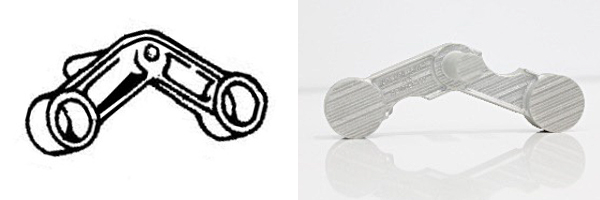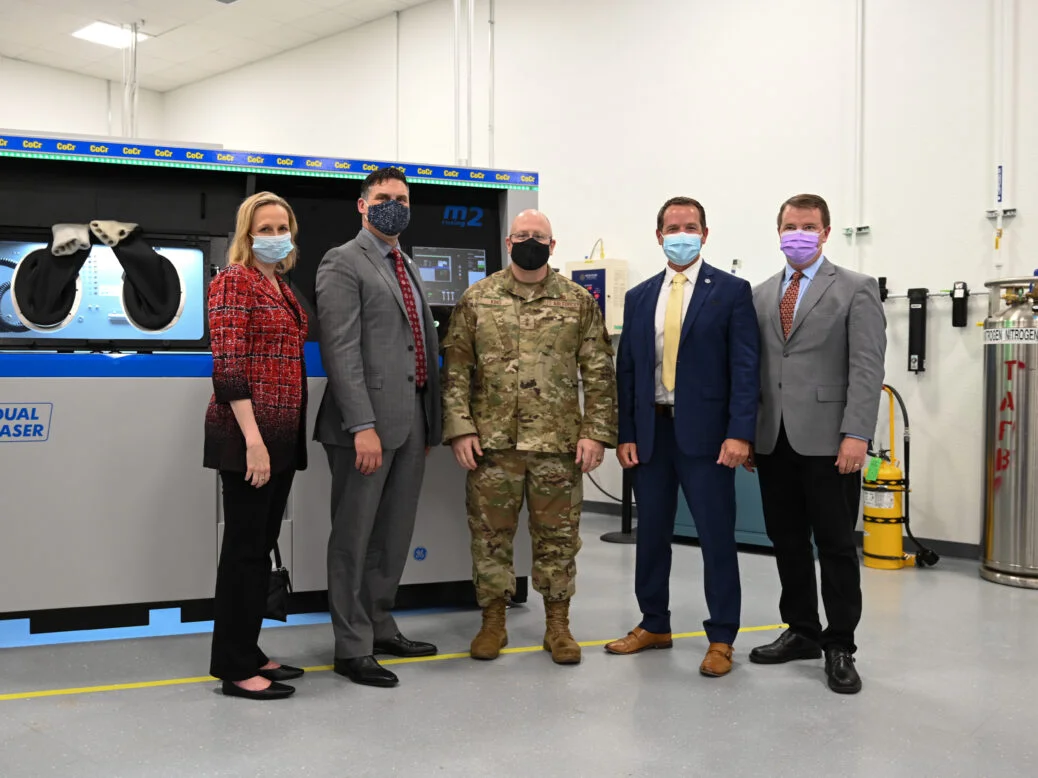The Pacer Edge program underway by the U.S. Air Force (USAF) and General Electric (GE) is making steady progress, most recently demonstrated by the opening of a second Reverse Engineering and Critical Tooling (REACT-II) laboratory. The REACT-II lab established by US Air Force Life Cycle Management Center’s (AFLCMC) Propulsion Directorate and Oklahoma City Air Logistics Complex (OC-ALC) will boast two GE Concept Laser metal 3D printers to drive forward the Pacer Edge program.
Pacer Edge and 3D Printing Aircraft Parts
Pacer Edge is a pathfinder program meant to apply additive manufacturing (AM) technology to the operation and maintenance of aircraft, typically in finding ways to produce parts that would otherwise be cast and have a long lead time. This resulted in the 3D printing of a sump cover for the F110 engine used to powder F-15 and F-16 fighter jets, making it the first jet engine part fabricated with metal 3D printing to be qualified by any Department of Defense body. Digital twinning, maintenance-based predictive analysis, and lifecycle management of the sump cover were also explored.
 Left: A hand-drawn technical illustration of the cross-shaft arm dating from the 1960s. Image Credit: USAF. Right: The first successful development build of the cross-shaft arm was printed nine months after requirement flow down. Image Credit: GE.
Left: A hand-drawn technical illustration of the cross-shaft arm dating from the 1960s. Image Credit: USAF. Right: The first successful development build of the cross-shaft arm was printed nine months after requirement flow down. Image Credit: GE.By demonstrating that such a component could be made, the program moved onto items with increased complexity and scale. This included obsolete parts such as a bellcrank, gearbox seat, anti-icing valve body, and a cross shaft arm. In addition to maintaining aircraft with obsolete parts, the Pacer Edge program is able to cut production time by 80 percent.
3D Printing Jet Engine Parts
Now, the work has led to the creation of a second REACT lab at Tinker Air Force Base, with two metal 3D printers from the Pacer Edge program. In particular, the USAF hopes to support engine components.
 (From left to right) Amy Gowder, president & CEO of GE Military Systems, John Sneden, director of the Air Force Life Cycle Management Center’s Propulsion Directorate, Maj. Gen. Jeff King, commander of the Oklahoma City Air Logistics Complex, Geoffrey Camp, director of Oklahoma’s Aerospace and Defense initiative, and Chris Schuppe, general manager of engineering and technology at GE Additive, stand in front of additive manufacturing 3D printer. PHOTO BY: 2nd Lt Leyinzca Bihlajama
(From left to right) Amy Gowder, president & CEO of GE Military Systems, John Sneden, director of the Air Force Life Cycle Management Center’s Propulsion Directorate, Maj. Gen. Jeff King, commander of the Oklahoma City Air Logistics Complex, Geoffrey Camp, director of Oklahoma’s Aerospace and Defense initiative, and Chris Schuppe, general manager of engineering and technology at GE Additive, stand in front of additive manufacturing 3D printer. PHOTO BY: 2nd Lt Leyinzca Bihlajama“The printer will be used for the production of propulsion items such as tooling and engine parts,” said Jason McCurry, Reverse Engineering, and Critical Tooling flight chief. “The biggest impact is the ability to produce parts that are no longer manufactured.”
“The propulsion directorate embraced additive manufacturing because of one big strategic reason and that is to improve propulsion readiness for the warfighter,” said John Sneden, director of Air Force Life Cycle Management Center’s Propulsion Directorate. “Additive manufacturing puts us in the driver’s seat so we can source those low volume hard to get parts at the speed of need.”
At this point, the Pacer Edge program is more or less established and successful, meaning that, when the USAF needs a replacement part, it shouldn’t be too difficult to implement the workflows established thus far. The next step would be continue scaling up facilities, something that GE Aerospace certainly knows a good deal about, given its own massive AM operations for production parts. Meanwhile, other areas of the U.S. military are adopting the technology in a similar manner but based around their own specific needs. This includes the U.S. Navy, which has had a somewhat more delayed foray into 3D printing, but is now exploring the technology in earnest.
Subscribe to Our Email Newsletter
Stay up-to-date on all the latest news from the 3D printing industry and receive information and offers from third party vendors.
You May Also Like
Printing Money Episode 18: The DC Fly-In with Mark Burnham, AddMfgCoalition
It’s only been a week since the previous show, but Printing Money is back already with Episode 18. Certain events call for Printing Money’s coverage, and the recent 2nd Annual...
Aerospace OEM Invests $9.1M in Michigan for Metal 3D Printing and More
Barron Industries, a foundry based in Michigan specializing in serving the aerospace and defense sectors, has made a $9.1 million capital investment to expand its operations in Oxford, Michigan. The...
Can Higher Power Density Engines Lead to Broader 3D Printing Use?
Traditionally, when it comes to sports cars, interest has centered around metrics such as horsepower per cubic inch and power-to-weight ratios. These metrics are calculated and interpreted differently by various...
Wisconsin’s Evology Adds Digital Sheet Forming to Service Roster
Evology, a service bureau based in Wisconsin and specializing in serving strategic sectors like aerospace and defense, has added digital sheet forming (DSF) to its repertoire of manufacturing capabilities. Evology...
































